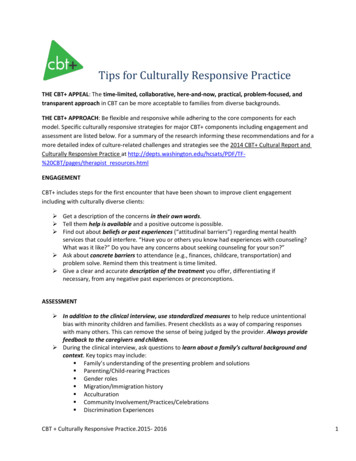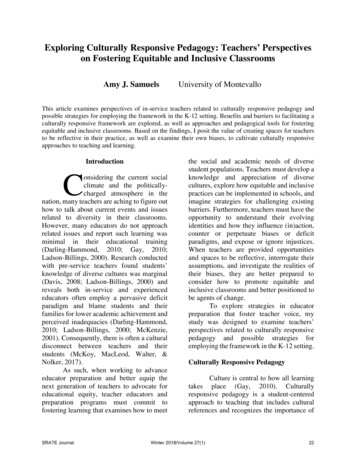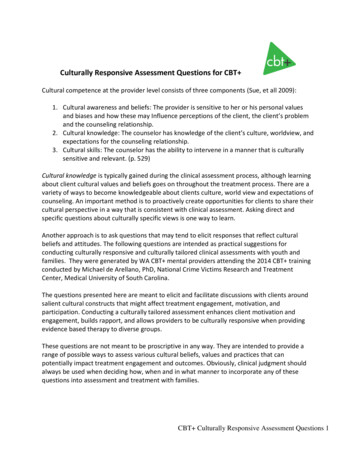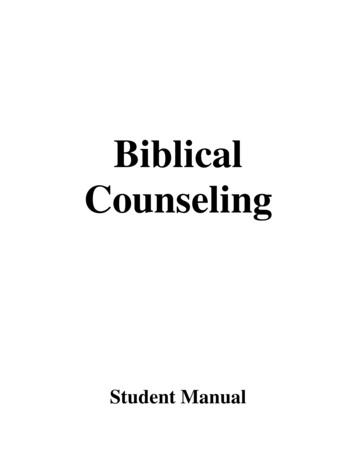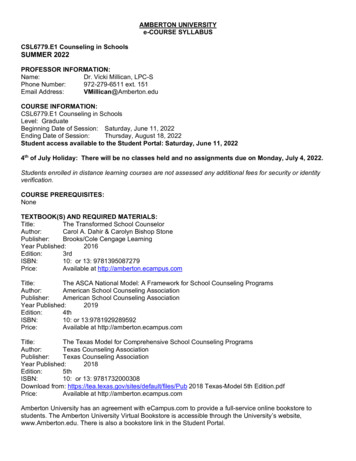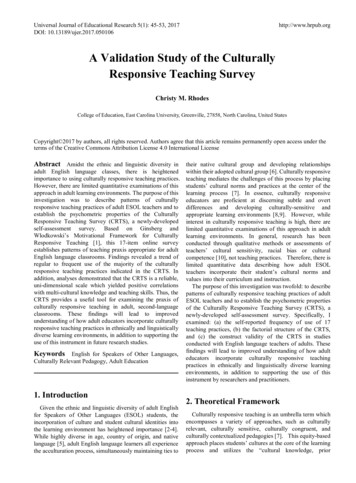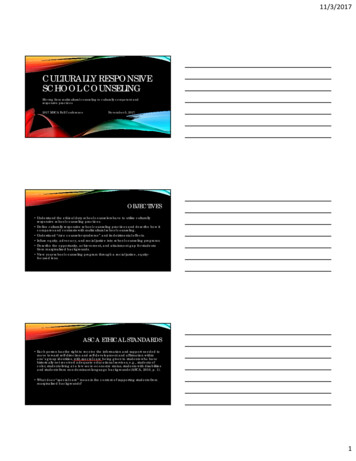
Transcription
11/3/2017CULTURALLY RESPONSIVESCHOOL COUNSELINGMoving from multicultural counseling to culturally competent andresponsive practices2017 MSCA Fall ConferenceNovember 5, 2017OBJECTIVES Understand the ethical duty school counselors have to utilize culturallyresponsive school counseling practices. Define culturally responsive school counseling practices and describe how itcompares and contrasts with multicultural school counseling. Understand “nice counselor syndrome” and its detrimental effects. Infuse equity, advocacy, and social justice into school counseling programs. Describe the opportunity, achievement, and attainment gap for studentsfrom marginalized backgrounds. View your school counseling program through a social justice, equityfocused lens.ASCA ETHICAL STANDARDS Each person has the right to receive the information and support needed tomove toward self-direction and self-development and affirmation withinone’s group identities, with special care being given to students who havehistorically not received adequate educational services, e.g., students ofcolor, students living at a low socio-economic status, students with disabilitiesand students from non-dominant language backgrounds (ASCA, 2010, p. 1). What does “special care” mean in the context of supporting students frommarginalized backgrounds?1
11/3/2017COMPARE AND CONTRASTMulticultural CounselingCulturally Responsive Counseling 3 C’s: Collaboration, consultation,cooperation Multicultural counseling and Cultural awareness and beliefs Advocacy orientation (Bemak & Chung, 2005) Cultural knowledge Social justice focus (Holcomb-McCoy &Gonzalez, 2016) Cultural skills Racial attitudes and perceptions Equity lens (Chen-Hayes et al., 2011) Student empowerment (Hipolito-Delgado &Lee, 2007) Data-driven counseling practices (Militello &Janson, 2014)Asset-based vs. deficit-based approaches (Welton & Martinez, 2013)NICE COUNSELOR SYNDROME (NCS)CharacteristicsDetrimental Effects Promotes harmony with others whileavoiding and deflecting interpersonalconflicts Assume roles of mediator and problemsolver Frequently agree to take onadministrative and clerical tasks Employ counseling strategies that assiststudents in learning new coping skills toadapt to situational stressors andinequitable practices rather thanaddressing them head on with and forstudents Unwillingness to take on socialjustice and equity-focused topics forfear of jeopardizing their “nicecounselor” status Willingness to take on non-guidanceand fair share responsibilities oftenovershadows their willingness andability to take on other tasks,especially those that may becontroversial or conflictual Perpetuate the status quoAdapted from Bemak & Chung, 2008CULTURALLY RESPONSIVESCHOOL COUNSELORS Investigate their own cultural or ethnic heritage Attend workshops, seminars, and conferences onmulticultural and diversity issues Join counseling organizations focused on cultural and socialjustice equity competencies Read literature written by culturally diverse authors Become familiar with multicultural education literature(Holcomb-McCoy & Chen-Hayes, 2011)2
11/3/2017ACHIEVEMENT GAP VS.OPPORTUNITY GAP Achievement gap teacher quality gap teacher training gap challengingcurriculum gap school funding gap digital divide gap wealth and income gap employment opportunity gap affordable housing gap health care gap nutritiongap school integration gap quality childcare gap [other systemic gaps of whichachievement gaps are typically a consequence] (Irvine, 2010) Opportunity gap differential access to resources, experiences, and capital towhich achievement and attainment measures are pervasively tied (Milner, 2010) Education debt: historical, economic, sociopolitical, and moral debts (LadsonBillings, 2006)MODEL FOR SOCIAL JUSTICEPROBLEM-SOLVING Individual IIdentify Community Resources EEducate and Train Public Policy (District, State, andFederal Levels) NNegotiate and Collaborate AAction School Environment Professional DevelopmentAdapted from Morales, Ham, & Morales, 2016.VIGNETTES What are the key issues related to culturally responsive school counseling? What is the first thing you would do in the situation? What would be the broader, longer term goal?3
11/3/2017REFERENCESAmerican School Counselor Association (ASCA) (2010). Ethical standards for school counselors. Alexandria, VA: Author.Bemak, F., & Chung, R.C. (2005). Advocacy as a critical role for urban school counselors: Working toward equity and social justice.Professional School Counseling, 8(3), 196-202.Bemak, F., & Chung, R. C. (2008). New professional roles and advocacy strategies for school counselors: A Multicultural/Social justiceperspective to move beyond the nice counselor syndrome. Journal of Counseling and Development, 86(3), 372-382.Chen-Hayes, S. F., Miller, E. M., Bailey, D. F., Getch, Y. Q., & Erford, B. T. (2011). Leadership and achievement advocacy for everystudent. In B.T. Erford (Ed.), Transforming the school counseling profession (3rd ed., pp. 110-128). Upper Saddle River, NJ: PearsonEducation.Hipolito-Delgado, C.P., & Lee, C.C. (2007). Empowerment theory for the professional school counselor: A manifesto for what reallymatters. Professional School Counseling, 10(4), 327-332.Holcomb-McCoy, C., & Chen-Hayes, S.F. (2011). Culturally competent school counselors: Affirming diversity by challenging oppression.In B.T. Erford (Ed.), Transforming the school counseling profession (3rd ed.) (pp. 90-109). Upper Saddle River, NJ: Pearson Education.Holcomb-McCoy, C., & Gonzalez, I. (2016). Counseling in schools: Issues and practice. In P.B. Pedersen, W.J. Lonner, J.G. Draguns, J.E.Trimble, & M.R. Scharron-del Rio, Counseling across cultures, (7th ed., pp. 247-272. Thousand Oaks, CA: Sage Publications, Inc.Irvine, J.J. (2010). Foreword. In H.R. Milner’s (Ed.), Culture, curriculum, and identity in education. New York: Palgrave Macmillan.Militello, M., & Janson, C. (2014). The urban school reform opera: The obstructions to transforming school counseling practices.Education and Urban Society, 46(7), 743-772.Milner, H. R., IV. (2010). Start where you are, but don't stay there: Understanding diversity, opportunity gaps, and teaching in today'sclassrooms. Cambridge, MA: Harvard Education Press.Morales, E., Ham, A., & Morales, A. U. (2016). Multicultural social justice advocacy in urban education. Presentation at California StateUniversity. Accessed on November 1, 2017, at www.schoolcounselor.org.Welton, A.D., & Martinez, M.A. (2013). Coloring the college pathway: A more culturally responsive approach to college readiness andaccess for students of color in secondary schools. Urban Review, 46, 197-223.THANK YOU!Andy SchuermanSchool CounselorPark Hill South High Schoolschuermana@parkhill.k12.mo.us816-359-56524
Culturally Responsive School CounselingResources ListPrint ResourcesBemak, F., & Chung, R. C. (2008). New professional roles and advocacy strategies for schoolcounselors: A Multicultural/Social justice perspective to move beyond the nice counselorsyndrome. Journal of Counseling and Development, 86(3), 372-382.Bruce, A. M., Getch, Y. Q., & Ziomek-Daigle, J. (2009). Closing the gap: A group counselingapproach to improve test performance of African-American students. Professional SchoolCounseling, 12(6), 450-457.Dahir, C. A., & Stone, C. B. (2012). The transformed school counselor (2nd ed). Belmont, CA:Brooks/Cole.Davis, P., Davis, M. P., & Mobley, J. A. (2013). The school counselor's role in addressing theadvanced placement equity and excellence gap for African-American students.Professional School Counseling, 17(1), 32-39.Education Trust. (2009). The new vision for school counselors: Scope of the work. Washington,DC: Author. Retrieved on October 15, 2016, at ool-counselors-scope-of-the-work/Gay, G. (2010). Culturally responsive teaching: Theory, research, and practice (2nd ed.). NewYork: Teachers College Press.Hipolito-Delgado, C.P., & Lee, C.C. (2007). Empowerment theory for the professional schoolcounselor: A manifesto for what really matters. Professional School Counseling, 10(4),327-332.Holcomb-McCoy, C. (2007). School counseling to close the achievement gap: A social justiceframework for success. Thousand Oaks, CA: Corwin Press.Howard, G. R. (2016). We can’t teach what we don’t know (3rd ed.). New York: TeachersCollege Press.Ladson-Billings, G. (2006). From the achievement gap to the education debt: Understandingachievement in U.S. schools. Educational Researcher, 35(7), pp. 3-12.Ladson-Billings, G. (2013). Dreamkeepers: Successful teachers of African American children,2nd ed. Somerset, NJ: John Wiley & Sons.McIntosh, P. (1986). White privilege and male privilege: A personal account of coming to seecorrespondences through work in women's studies. Manuscript submitted for publication,Wellesley College, Boston.
Militello, M., & Janson, C. (2014). The urban school reform opera: The obstructions totransforming school counseling practices. Education and Urban Society, 46(7), 743-772.Milner, H. R., IV. (2010). Start where you are, but don't stay there: Understanding diversity,opportunity gaps, and teaching in today's classrooms. Cambridge, MA: HarvardEducation Press.Nieto, S. (2013). Finding joy in teaching students of diverse backgrounds: Culturally responsiveand socially just practices in U.S. classrooms. Portsmouth, NH: Heinemann.Parikh, S. B., Post, P., & Flowers, C. (2011). Relationship between a belief in a just world andsocial justice advocacy attitudes of school counselors. Counseling and Values, 56, 57-72.Schellenberg, R., & Grothaus, T. (2011). Using culturally competent responsive services toimprove student achievement and behavior. Professional School Counseling, 14(3), 222230Singh, A. A., Urbano, A., Haston, M., & McMahon, E. (2010). School counselors’ strategies forsocial justice change: A grounded theory of what works in the real world. ProfessionalSchool Counseling, 13(3), 135-145.Smith-Adcock, S., Daniels, M. H., Lee, S. M., Villalba, J. A., & Indelicate, N. A. (2006).Culturally responsive school counseling for Hispanic/Latino students and families: Theneed for bilingual school counselors. Professional School Counseling, 10(1), 92-101.Stephens, D.L., & Lindsey, R. B. (2011). Culturally proficient collaboration: Use and misuse ofschool counselors. Thousand Oaks, CA: Corwin Press.Sue, D.W., & Sue, D. (2012). Counseling the culturally diverse: Theory and practice (6th ed.).Hoboken, NJ: John Wiley & Sons, Inc.Trusty, J., & Brown, D. (2005). Advocacy competencies for professional school counselors.Professional School Counseling, 8, 259-265.Trusty, J., Mellin, E. A., & Herbert, J. T. (2008). Closing achievement gaps: Roles and tasks ofelementary school counselors. The Elementary School Journal, 108(5), 407-421.Valencia, R. (2010). Dismantling contemporary deficit thinking: Educational thought andpractice. New York, NY: Routledge.Welton, A.D., & Martinez, M.A. (2013). Coloring the college pathway: A more culturallyresponsive approach to college readiness and access for students of color in secondaryschools. Urban Review, 46, 197-223.
Web ResourcesASCA (2015). The school counselor and cultural diversity. American School CounselorAssociation. Retrieved September 19, 2016, at mbers/about-asca-(1)/position-statements.20 (Self-)Critical Things I Will Do to Be a Better Multicultural ources/self critique.htmlSupporting Undocumented High School Students: mented-students-highschool-and-collegeGLSEN – Supporting lesbian, gay, bisexual, transgender, and questioning students:https://www.glsen.org/
Understand the ethical duty school counselors have to utilize culturally responsive school counseling practices. . Park Hill South High School schuermana@parkhill.k12.mo.us 816-359-5652 . Culturally Responsive School Counseling . Resources List . Print Resources .

